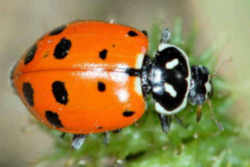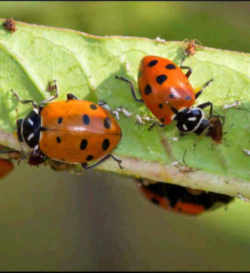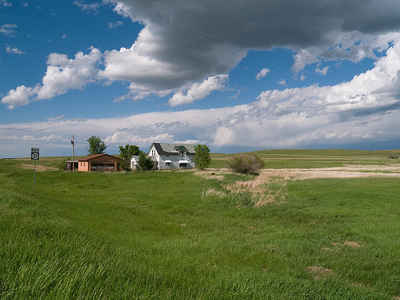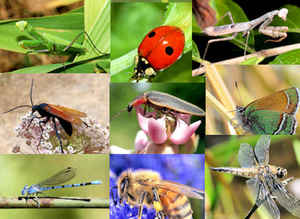North Dakota State Insect
Ladybug

(Hippodamia convergens)
Adopted on March 15, 2011.
On March 15, 2011 Gov. Jack Dalrymple signed into law House Bill 1219, designating the Convergent Lady Beetle, (Hippodamia convergens,) commonly known as the ladybug, as the official state insect. He was joined at the cermony by legislators and second grade students from Kenmare Elementary School, who were instrumental in passing the legislation.
The students, who were from Tamara McNeiley's enrichment class, were studying ladybugs and learned that while 42 states had a state insect, North Dakota did not. They researched the ladybug and initiated the legislation designating the ladybug as the state's official insect. The students testified before the House and Senate Political Subdivisions committees in support of the legislation.
"This legislation not only designates an official insect for our state, but also exemplifies the importance of having a voice and how each of us has the ability to affect change and have an impact on our state," Dalrymple said. "These students and their teacher, Mrs. McNeiley, represent the outstanding work that is going on in classrooms across our state, work that is instilling in our young people the skills and values to be tomorrow's leaders."
In October 2009, the students contacted Rep. Glen Froseth, who supported them in their efforts to initiate the legislation. He signed on as the primary bill sponsor, along with Reps. Pat Hatlestad and Gary Kreidt and Sen. Karen Krebsbach.
The Ladybug is the Official State Insect of six states; New York, North Dakota, Ohio, Massachusetts, New Hampshire and Tennessee. The Lady Bug is the Official State "Bug" of Delaware.
North Dakota State Insect: Ladybug

Hippodamia convergens, commonly known as the convergent lady beetle, is one of the most common lady beetles in North America and is found throughout the continent. Aphids form their main diet and they are used for the biological control of these pests. Ladybugs are sold to farmers to control insect pests because they are important aphid predators. The life cycle is about four weeks as the ladybug larvae passes through four growth stages feeding on insects and insect eggs. The reddish-orange ladybug has distinctive black spots on each wing cover.
It helps farmers by controlling insect pests, especially aphids. In folk medicine, ladybugs were believed to cure various diseases such as colic and measles. In folk medicine ladybug beetles were used to cure various diseases including colic and the measles.
Characteristics of the North Dakota Ladybug
Adults
The female lady beetle lays 200 to 300 eggs over several months during spring and early summer. The eggs are small and spindle-shaped and are laid near the prey in upright batches of fifteen to thirty eggs. The larvae are dark and somewhat alligator-shaped.
Defense
Bright colors generally indicate that the insect is armed and dangerous! In this case the ladybird is advertising it's bitter taste. When handled the ladybird will exude drops of pungent fluid which stain the hand and taint it with a long-lasting smell.
Feeding
As with most in this family, ladybirds will eat huge numbers of aphids in both the larval and adult stages. Once the larvae begin feeding, they grow quickly and moult four times over a period of up to a month. The pupal stage lasts about a week and mating takes place soon afterwards. If there is an abundant supply of aphids the female may start laying within about a week of mating, but if the supply is scanty, she may wait for up to nine months.
LARVA
carnivorous, aphids
Some Facts About Ladybugs:
- Ladybugs are the most popular and widely used beneficial insects for commercial and home use. Ladybugs are capable of consuming up to 50 to 60 aphids per day but will also eat a variety of other insects and larvae including scales, mealy bugs, leaf hoppers, mites, and various types of soft-bodied insects, and are one of the most active predators, searching from dawn to dusk for food.
- Ladybugs will consume over 5,000 aphids each in their lifetime. Pollen and nectar are necessary for maturation of newly emerged ladybug adults, particularly before a winter hibernation season. Adults can survive on pollen and nectar for limited periods, but a supply of aphids or other prey is necessary for egg production.
- Ladybugs become active at about 59 degrees Fahrenheit.
- Ladybugs are cold-blooded and hibernate in cold weather.
- There are nearly 5,000 different kinds of ladybugs worldwide - 400 of which live in North America.
- A ladybug's top flying speed is about fifteen miles per hour.
- Ladybugs lay their eggs where aphids are present. Both lady bugs and their larvae eat aphids. The eggs of ladybugs are not visible to the naked eye.
- A female ladybug will lay more than 1000 eggs in her lifetime.
- Ladybugs are a type of beetle. All species of ladybugs have short legs. This separates them from other beetles.
- Ladybugs chew from side to side and not up and down like people do.
- The Ladybug is the Official State Insect of six states; New York, North Dakota, Ohio, Massachusetts, New Hampshire and Tennessee. The Lady Bug is the Official State "Bug" of Delaware.
- A ladybug excretes a yellowish liquid when it is threatened. The liquid has a terrible smell to its predators.
- The Asian Lady "Beetle" can live up to 2-3 years if the conditions are right.
North Dakota House Bill 1219
Sixty-second Legislative Assembly of North Dakota
In Regular Session Commencing Tuesday, January 4, 2011
HOUSE BILL NO. 1219
(Representatives Froseth, Hatlestad, Kreidt)
(Senator Krebsbach)
AN ACT to create and enact a new section to chapter 54-02 of the North Dakota Century Code, relating to the designation of the ladybug as the official
state insect.
BE IT ENACTED BY THE LEGISLATIVE ASSEMBLY OF NORTH DAKOTA:
SECTION 1. A new section to chapter 54-02 of the North Dakota Century Code is created and
enacted as follows:
State insect.
The convergent lady beetle, hippodamia convergens, commonly known as a ladybug, is the official insect of the state of North Dakota.
North Dakota Law
The law designating the convergent lady beetle as the official North Dakota state insect is found in the North Dakota Revised Statutes, Title 54, Chapter 54-02, Section 54-02-19
TITLE 54 STATE GOVERNMENT.
CHAPTER 54-02 STATE EMBLEMS, SYMBOLS, AND AWARDS
SECTION 54-02-19
54-02-19. State insect.
The convergent lady beetle, hippodamia convergens, commonly known as a ladybug, is the official insect of the state of North Dakota.
Taxonomic Hierarchy: Convergent Lady Beetle
Kingdom: Animalia (Animals)
Phylum: Arthropoda (Arthropods)
Subphylum: Hexapoda (Hexapods)
Class: Insecta (Insects)
Order: Coleoptera (Beetles)
Suborder: Polyphaga (Water, Rove, Scarab, Long-horned, Leaf and Snout Beetles)
No Taxon: (Series Cucujiformia)
Superfamily: Coccinelloidea
No Taxon: (Coccinellid group)
Family: Coccinellidae (Lady Beetles)
Subfamily: Coccinellinae
Genus: Hippodamia
Species: convergens (Convergent Lady Beetle)
Butterflies, and Bugs








